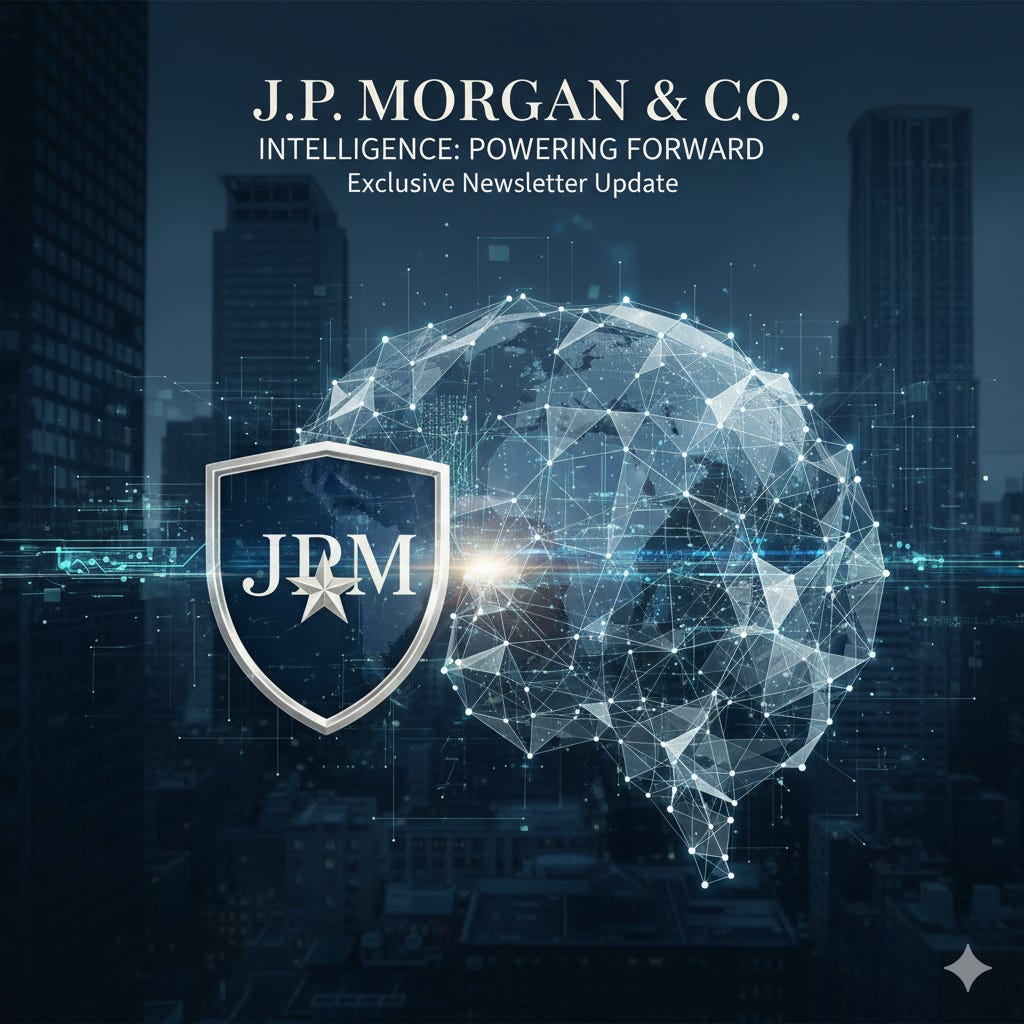JPMorgan and the Rise of the Co-Intelligent Organisation
When JPMorgan Chase committed $18 billion to embed AI across its enterprise, most headlines called it a technology upgrade. Look closer and you’ll see something more radical: a deliberate shift toward becoming a co-intelligent organisation—where human expertise and artificial intelligence work in rhythm to amplify capabilities across the business.
JPMorgan’s Co-Intelligence Blueprint
The bank’s vision is layered and ambitious. Every employee gets a personal AI assistant. AI agents orchestrate complex workflows. Client interactions are supported by AI concierges. This isn’t automation for efficiency’s sake—it’s what researchers call collaborative intelligence: the fusion of human judgment and machine processing to achieve outcomes neither could manage alone.
Derek Waldron, the bank’s Chief Analytics Officer, calls it a “fundamental rewiring.” Not cost-cutting. Not substitution. A conscious choice to multiply human cognition. In fact, 80% of executives now agree: hybrid human–machine intelligence delivers better results than either working alone.
The trajectory is clear:
Foundations: LLM Suite, connecting 250,000 employees to frontier models with proprietary data as fuel.
Progression: From productivity tools to agentic AI capable of multi-step decision-making.
Workforce redesign: Flatter, AI-augmented teams where humans move up the value chain.
Credit underwriting offers a living example: AI handles document collection and analysis, while humans engage in conversations, site visits, and final decisions. Productivity rises, but human judgment remains the anchor.
The Dimon Doctrine: AI as a Transformational Force
The driving force behind JPMorgan’s ambition is the clear and consistent vision of its Chairman and CEO, Jamie Dimon. In annual letters to shareholders and public forums, Dimon has placed AI in historic company—“extraordinary and possibly as transformational as the printing press, electricity, and the internet.”
This is not corporate flourish; it is a strategic directive. Dimon’s framing sets a tone of urgency and inevitability, positioning AI as a critical determinant of future profitability and competitive advantage. By anchoring AI in a narrative of epochal change, he ensures the initiative receives not just funding, but cultural alignment and organizational priority.
Dimon has also been candid with employees: AI will augment many roles but may also “eliminate some careers.” This stark honesty serves a dual purpose. It preempts resistance by managing expectations, and it signals that the coming transformation is non-negotiable. The Dimon Doctrine is less about technology and more about powerfully aligning strategy, culture, and capital around AI as destiny.
Enter the Helix Perspective
This transformation gains depth when viewed through the Helix framework from my forthcoming book The Helix Moment: How to Think, Lead, and Design in the Co-Intelligence Age.
At the heart of Helix thinking are three rhythms:
Lines (▲) for clarity and structure—repeatable processes that scale.
Loops (●) for adaptation and feedback—systems that learn by doing.
Vibes (〰) for sensing emergence—stretching into the unknown and capturing possibility.
JPMorgan’s eight-week LLM Suite rollout? A Line.
The shift to agentic AI handling multi-step workflows? A Loop.
The bold vision of AI concierges embedded in every client conversation? Pure Vibe.
Four Modes of Human–AI Collaboration
The Helix model also identifies four collaboration modes that guide maturity:
AI as Amplifier → Speeding up execution (e.g., 30-second investment presentations).
AI as Mirror → Stress-testing strategy and revealing blind spots.
AI as Partner → Co-creating solutions through iterative collaboration.
AI as Capability → Delegating workflows to autonomous agents with human oversight.
Most organisations stall at Amplifier. JPMorgan is advancing toward Capability—while dipping into Mirror and Partner modes in innovation teams.
Rhythm Mismatches and Strategic Dysfunction
Organisational failure often comes not from bad strategy but from rhythm misalignment. A bank stuck in Lines becomes rigid. One lost in Vibes lacks scale. JPMorgan’s careful balancing act—structured rollouts, iterative experimentation, emergent visions—shows what rhythm literacy looks like in practice.
In the Helix view, the question isn’t “how much AI should we adopt?” but what rhythm are we in, and what rhythm do we need?
Toward the Multi-Rhythm Organisation
Different functions must move at different speeds:
Finance runs Lines for compliance.
Innovation labs run Loops for discovery.
Customer teams sense Vibes at the market edge.
The future of co-intelligent organisations lies in orchestrating these rhythms—turning friction into bridges. JPMorgan is rehearsing this future now.
Why This Matters
AI doesn’t just change workflows. It changes how organisations think, learn, and design themselves. JPMorgan’s story is not about finance alone—it’s a prototype for how any organisation can rewire itself into a co-intelligent system.
The true measure won’t be automation rates. It will be the quality of human–AI collaboration, the rhythm literacy of leaders, and whether intelligence becomes distributed across the enterprise.
Because the deeper question every leader now faces is this:
What does your AI know that no other AI knows?


